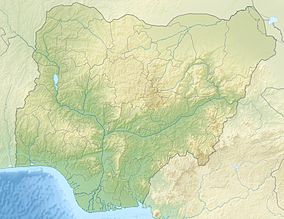Akure Forest Reserve
| Akure Forest Reserve | |
|---|---|
IUCN category V (protected landscape/seascape) | |
Map of Nigeria | |
| Location | Ondo State, Nigeria |
| Nearest city | Akure |
| Coordinates | 7°17′46″N 5°01′48″E / 7.296°N 5.03°E[1] |
| Area | 66 km2 (25 sq mi) |
Akure Forest Reserve is a protected area in southwest Nigeria, covering 66 km2 (25 sq mi).[2]
In recent decades, there has been a large deforestation in this area, which has a huge impact on the environment.[3] Akure Forest reserve is a forested area set aside for preservation or controlled use and located at Ile Oluji/Okeigbo, Ondo State, Nigeria, with a Latitude of 7° 17′ 39″ N and Longitude of 5° 2′ 3″ E. [4]
Geographical area
The Akure Forest Reserve is situated in the Ondo State, Nigeria, a region in Akure South Local Government Area (Fig. 2). It falls within longitudes 5o9′ and 5o11′ east of the Greenwich Meridian and latitudes 7o16′ and 7o18′ north of the equator [5] It was established as a reserve in 1936. It covers a land area of about 69.93km2. Politically, it is located in Ondo State in southwest Nigeria and shares a border with Osun State in the northeast. Ondo State is home to five LGAs, including: Ile Oluji, Oke-Igbo, Ifedore, Akure South, Idanre and Ondo East.
Adetula[6] estimated that 11.73% (8.2 km2) of the area had been cleared for cocoa farming and other food crops; Fuwape et al.[7] documented the Gmelina arborea covered (721.40 m3) and Nauclea diderrichii spp. (265.18 m3), respectively; Oke[8] worked on the family Sterculiaceae including the species counted for 53% of the total tree canopies in. According to key informants surveyed for Owusu (2018)'s[9] research, the disappearance of vegetation in the city raises livability issues with regard to ecosystem function, temperature rise, and air quality. As a result, he advised policymakers to address the three crucial issues of resilience, sustainability, and livability. In the southern section of the relief pattern, which ranges in elevation from 216 meters to 504 meters and is gently undulating, mountainous rock outcrops are spaced closely together while in the northern part.Gneiss and crystalline rocks make up the ground beneath. It has a pH range of 6.7 to 7.3 and is sandy-loam in composition. The wet season begins in April and ends in October, with the heaviest rainfall records occurring in July and August (Akinseye).[10] According to Adejoba et al.,[11] the average daily temperature ranges between 210C and 290C for nearly the entire year. The dry season lasts from November to March. The average annual rainfall varies from 2000mm in the south to 1500mm in the north, with yearly relative humidity in the south-west ranging from 80-85% (NiMET, 2016). The forest was owned by the Aponmu and Owena Yoruba speaking groups, although it was also surrounded by small towns. These include Elemo Igbara Oke Camp, Ipogun, Kajola/Aponmu, Kajola, Ago Petesi, Akika Camp, Owena Town, Ibutitan/Ilaro Camp, and Kajola/Aponmu.
References
- ^ "Akure Forest Reserve". protectedplanet.net.
- ^ World Database on Protected Areas[permanent dead link]
- ^ "Analysis of Pattern and Extent of Deforestation in Akure Forest Reserve, Ondo State, Nigeria".
- ^ "Monitoring Akure Forest Reserve Change Over Time – Sambus Geospatial". Retrieved 2022-09-09.
- ^ Komolafe, Olufemi Odunayo (14 - 20th August, 2022). "Geospatial Modelling of Akure Forest Reserve in Ondo State, Nigeria" (PDF). Proceedings of the 8th Biennial Conference of the Forests and Forest Products Society. pp. 346–357 (PDF).
{{cite news}}: Check|archive-url=value (help); Check date values in:|date=(help) - ^ Adekunle, V.A.J., Olagoke, A.O., Ogundare, L.F. 2013. Logging impacts in tropical lowland humid forest on tree species diversity and environmental conservation. Applied Ecology and Environmental Research11(3), 491–511. DOI: 10.15666/aeer/1103_491511
- ^ Fuwape, J.A., Onyekwelu, J.C.,Adekunle, V.A.J. 2001. Biomass equations and estimation for Gmelina arborea and Nauclea diderrichii stands in Akure forest reserve. Biomass and Bioenergy21 (6) 401–405. DOI: 10.1016/s0961-9534(01)00036-8
- ^ Oke,D.O 2012. Effects of shortrotation natural fallow on diversity of plant species and population of soil microbesin Aponmu, Ondo state, Nigeria.Journal of Tropical Forest Science 24(1),18–26.https://www.jstor.org/stable/23616948
- ^ Owusu, A. B.2018. An assessment of urban vegetation abundance in Accra metropolitan area, Ghana: a geospatial approach. Journal of Environmental Geography 11 (1–2), 37–44. DOI: 10.2478/jengeo-2018-0005
- ^ Akinseye,2010.Climate variability and effects of weather elements on cocoa and cashew crops in Nigeria. Master Thesis, Department of Agriculture, Federal University of Technology Akure, Ondo state, Nigeria.
- ^ Adejoba, O., Kleine M., Taboada T. 2014. Reducing deforestation and forest degradation and enhancing environmental services from Forests (REDDES), with support from the International Tropical Timber Organization (ITTO), IUFRO-SPDC and FORNESSA, Akure, Ondo, Nigeria.Online available at: https://www.iufro.org/download/file/18240/5656/FORNESSA_Factsheet_Nigeria_final_pdf/
